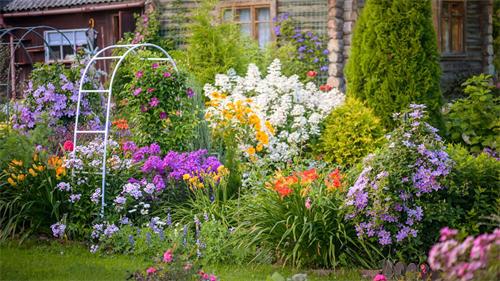
Color-blocking with perennials is a dynamic garden design technique that transforms ordinary flowerbeds into striking visual displays. By grouping plants in bold, cohesive palettes and arranging them in impactful “blocks,” gardeners can create harmony and drama simultaneously. This approach not only enhances aesthetic appeal but also simplifies maintenance and ensures seasonal interest.
Color-blocking involves massing plants of similar or complementary hues together to create bold, unified sections within a garden. This method relies on both complementary and analogous color schemes: complementary colors sit opposite each other on the wheel (e.g., orange and blue), while analogous hues are neighbors (e.g., blue and purple), both yielding cohesive displays when massed. By limiting the color palette to a few key shades, gardeners can avoid visual clutter and achieve a more harmonious look.
Selecting Your Perennial Palette
Limiting and Layering Colors
Aim for 3–5 main colors to strike a balance between variety and clarity. If you venture beyond five, focus on shades of your core hues to maintain cohesion. Layering colors in horizontal bands—bright reds or oranges at one end fading through pastels to whites—creates a gradient effect that guides the eye through the garden.
Choosing Perennial Companions
Perennials such as salvia, delphinium, and campanula offer strong blue and purple tones, while coneflowers (Echinacea) and black-eyed Susans (Rudbeckia) bring bold oranges and yellows. For more structured combinations, consider pairing roses with blue salvia for classic elegance, or veronica with coneflowers for contrasting shapes and colors.
Designing the Layout
Mapping Your Beds
Begin by sketching your bed on graph paper (one square = one foot), then draw “color bubbles” in the sizes you intend to plant them. This helps visualize groupings and flow. Decide whether to follow a formal pattern (e.g., pink–red–white repeat) or adopt a more organic placement with varying block sizes and overlapping edges for a naturalistic feel.
Viewing Angles and Heights
Place taller plants like delphiniums or ornamental grasses toward the back if your bed faces one side; if it’s viewable from all angles, position tall specimens centrally, with shorter perennials radiating outward. Stagger heights within each color block to add depth—pair mid-height blooms (e.g., coneflower) with lower edge-definers such as creeping phlox or sedum.
Planting and Maintenance Tips
Mass Planting for Impact
Plant perennials in groups of 5–7 (or more) to ensure each color block reads clearly from a distance. Tight groupings amplify color intensity and reduce weedy gaps.
Season-Long Interest
If you want color blocks to last from spring into autumn, mix early-blooming bulbs (tulips, daffodils) with later perennials. To keep color blocks vibrant and prevent them from fading over time, split overcrowded clumps every two years and deadhead spent blooms.
Color-blocking with perennials is a powerful design strategy that brings clarity, cohesion, and boldness to flowerbeds. By carefully selecting a limited palette, organizing plants into striking masses, and planning for seasonal succession, gardeners can create living artworks that captivate from every angle and throughout the year. Embrace the drama of color-blocked designs, and let your garden bloom with confidence and flair!
Recommend:

The Ultimate Guide to Visiting the Acropolis and Parthenon in Athens (2024)

Whitsunday Wonders: Scenic Marvels of Australia's Great Barrier Reef Islands

How to Drink Mate like a Local?

6 Turkish Foods To Try–A Culinary Exploration of Turkey

